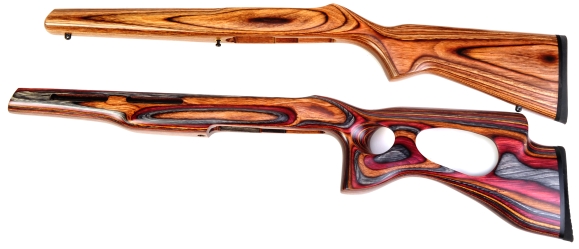One of the toughest decisions all Ruger 10/22 owners must eventually come to grips with is knowing when it’s time to rationalize that a stock smacking of video game imagery will further enhance their gun’s accuracy. In the case of the target model 10/22, it usually takes a little longer because the target model comes standard with a nice laminated… sort of varmint style stock. No, not the kind of stock varmints appreciate, but rather the type they will learn not to appreciate.

So there I was, shooting away with the factory stock, head popped up like a gopher, trying to line up with the eyepiece when my giant noggin began to list to one side, wavered for a moment, then rolled over, acutely and obliquely to the left until it’s fall was abruptly interrupted by the stock’s comb. Fifty rounds later, I realized I was staring through the scope with my left eye, and that’s when it dawned on me… I didn’t need a justification to put a spiffy new stock on my 10/22, other than I liked the way it looked. And, if it did have a higher comb that stopped my head from falling to one side while I was shooting, all the better.
Let me beat that point to death one more time…

The Ruger 10/20’s stock geometry is more suitable for use with metallic sights. Metallic sights are tucked in close to the receiver, so a good deal of drop at the stocks heal and comb are appropriate to get the shooter’s eye into natural alignment.
Drop is typically measured from a gun’s bore centerline to the top of the stock’s heel. In this case, because I was taking reference measurements to facilitate scope mounting, I measured from the crown of the receiver which put the Ruger drop is almost 2″ with a tracking comb angle. In comparison, the scoped Remington rifle designed for scope use (bottom), has only a ¾” drop and the comb is almost parallel to the bore.
For the Ruger, even assuming very low scope mounting, my natural line of sight would be 1″ inch below the center of the eyepiece. Not a whole lot to see there. Mounting a scope with a large objective bell on medium height rings would place the eyepiece center an additional 0.340″ above natural line of sight. Handling lots of rifles for brief periods of time, I’ve grown use to shooting those that don’t fit very well, rifles that often leave me looking like… Joe Bobble Head. Shooting accurately takes that more concentration and control and shooting over the long haul gets to be fatiguing. Since this a personal rifle, I thought I would take the time to find a stock that worked. A stock that would improve shooting comfort enough to make a difference in accuracy.
Whoa! Breakout the sunglasses!
The selected replacement stock is a Keystone Sporting Arms Revolution Extreme – Cayenne.Brownells # 100-004-046. Now if that look doesn’t just kind of jump out and slap you around the head and ears I don’t know what would. The Revolution is very cleanly formed and has a very nice satin finish. Compared to the factory piece, the drop at the heel is increased to 2½” which puts the butt plate in better location on the shoulder. The comb is dramatically raised to about 1½” higher than the factory piece. The pistol grip is basically vertical, which makes for a much more positive hold, and the hold is further enhanced with the thumb hole grasp and the forearm is wide… hand filling. At 2.35 lbs, The Keystone stock is not significantly heavier than the 2.30 lb factory piece. Pull length on both stocks is approximately 13 ¾”, which works for me… without firing up the band saw.

From a inletting and barrel channel standpoint, the Keystone piece is a very tight fit rather than the close, but not very tight action fit of the factory stock and the barrel float to the very last ¾” of forearm approach. I’d like to detail the installation process, but even I can’t expand on a one screw removal and install procedure. It’s easy – with the back of the action tipped into the stock, then the barreled action rotated down until the barrel is laid flush in the channel.
It’s not just about appearances… Well, maybe just a little

The factory configured Ruger 10/22 was OK, but not as steadying as I would have liked. Shooter’s comfort has a lot to do with a firearm’s performance, which is why people have triggers and actions slicked up and stocks modified. Below is a table that tracks twenty five yard accuracy for the gun, shot from the prone position, before and after the stock change.
|
Considering this is a standard rifle, with the exception of the scope and stock, I was please with the degree of improvement. I don’t think absolute accuracy showed a huge change, but all of the ammunition that showed a repetitive tendency to scatter with the factory stock was pulled into line with the better grouping ammunition.
The new stock’s higher comb makes the alignment with the scope natural. The nearly vertical pistol grip makes for better buttstock pressure control at the shoulder and at the face. The full forearm makes for much better support. The heavy barrels seems to tune ok to the channel contact. Now I can move the target out to 50 yards and perhaps move on to take a look at the fire control system.

Email Notification